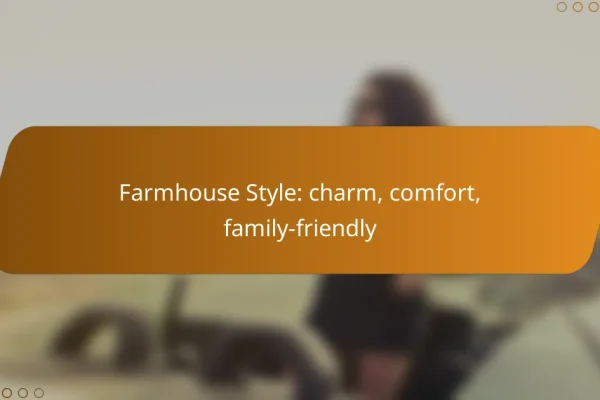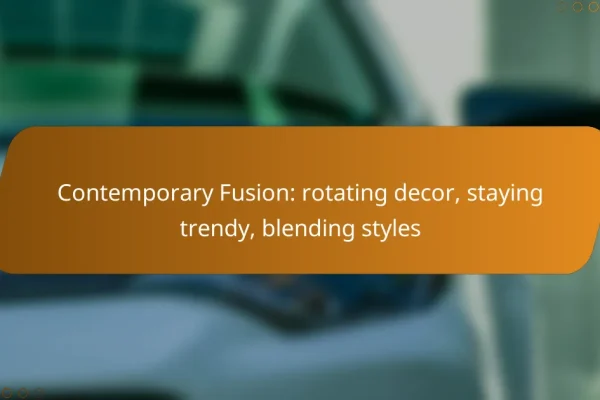
Eclectic Style: unique combinations, personal touches, layered textures
Eclectic style embraces unique combinations of design elements from various eras and cultures, allowing for…
Home decor styles offer a diverse array of options for personal expression and aesthetic appeal. From the sleek lines of Modern design to the warmth of Rustic charm, each style brings its own unique characteristics that can transform a space. Understanding your preferences and the specifics of your environment is essential in creating a cohesive and inviting home that truly reflects your personality.

Eclectic style embraces unique combinations of design elements from various eras and cultures, allowing for a personal and creative expression in home decor. By layering textures, mixing furniture styles, and incorporating bold colors, you can create a cohesive yet dynamic space that reflects your individuality. This approach encourages the use of distinctive art pieces and…

Embracing farmhouse style means celebrating the seasons with decor that reflects nature’s changes while ensuring a warm and inviting atmosphere. By incorporating seasonal colors, textures, and practical updates, you can enhance both the aesthetic charm and functionality of your space, making it comfortable year-round. How to decorate your farmhouse for each season? Decorating your farmhouse…

Embracing rustic charm in your living space brings warmth and comfort through the use of natural elements and cozy textures. By incorporating materials like reclaimed wood, stone, and soft textiles, you can create an inviting atmosphere that fosters a deep connection to nature. This design style not only enhances the aesthetic appeal but also promotes…

Mid-Century Modern design captures the essence of nostalgia through its emphasis on simplicity and functionality. Emerging in the mid-20th century, this iconic style is celebrated for its clean lines and innovative materials, creating a seamless connection between indoor and outdoor spaces. Incorporating these elements into your home can evoke a timeless aesthetic that honors both…

Farmhouse style embodies a perfect blend of charm and comfort, creating a warm and inviting atmosphere ideal for family living. By incorporating neutral colors, rustic furniture, and vintage decor, this design aesthetic fosters a sense of nostalgia and togetherness. Emphasizing natural materials and cozy textures, farmhouse decor encourages a welcoming environment that brings families closer…

Contemporary fusion in interior design emphasizes the art of rotating decor to seamlessly blend various styles and stay on-trend. By regularly updating your space with elements from diverse aesthetics like Scandinavian minimalism, industrial chic, and bohemian accents, you can create a dynamic and cohesive environment that reflects your personal taste. This approach not only keeps…

Shabby Chic decor beautifully combines vintage charm with soft colors and distressed finishes, creating a cozy and inviting atmosphere in any home. This style emphasizes a lived-in feel, making it perfect for those who appreciate a touch of nostalgia in their living spaces. How to achieve Shabby Chic decor in your home? To achieve Shabby…

Mid-Century Modern design is celebrated for its clean lines, organic shapes, and vibrant color palettes, creating a timeless aesthetic that blends functionality with style. Emerging in the mid-20th century, this movement emphasizes simplicity and open spaces, making it ideal for those seeking warmth and character in their homes. By incorporating iconic furniture and decor pieces,…

Eclectic style in home decor celebrates the beauty of diversity by blending various elements to create a space that is uniquely yours. This approach encourages creativity and individuality, allowing you to mix different furniture styles, colors, and textures that resonate with your personal taste. By thoughtfully curating a collection of unique accessories and decor items,…

Scandinavian simplicity in home design embodies a harmonious blend of clean lines, functional elements, and an airy atmosphere. By prioritizing minimalism and natural materials, this style creates serene and inviting spaces that are both aesthetically pleasing and practical. Light woods play a crucial role in enhancing the overall feel, making interiors feel open and welcoming….
In the United States, popular home decor styles include Modern, Rustic, Bohemian, Industrial, and Traditional. Each style has unique characteristics that reflect different aesthetics and preferences, allowing homeowners to express their individuality through design.
Modern style emphasizes minimalism and functionality, featuring clean lines and a neutral color palette. Furniture is often sleek and low-profile, with an emphasis on open spaces and natural light.
To achieve a modern look, focus on using materials like glass, metal, and wood. Avoid clutter by selecting a few statement pieces rather than overcrowding the space.
Rustic style draws inspiration from nature, incorporating elements like reclaimed wood, stone, and earthy tones. This style creates a warm and inviting atmosphere, often featuring handmade or vintage items.
To enhance a rustic decor, consider using natural fabrics such as linen or wool and incorporating elements like exposed beams or a stone fireplace. Accessories like woven baskets and antique furniture can add character.
Bohemian style is characterized by its eclectic mix of colors, patterns, and textures. This style encourages creativity and personal expression, often featuring a variety of global influences.
To create a Bohemian space, layer textiles, use bold colors, and mix different styles of furniture. Incorporate plants and unique decor items from travels to enhance the personal touch.
Industrial style is inspired by warehouses and factories, showcasing raw materials like metal, wood, and concrete. This style often features an open layout with exposed ductwork and brick walls.
To achieve an industrial look, focus on using furniture with a distressed finish and incorporate vintage lighting fixtures. Keep the color palette neutral, with occasional pops of color through accessories.
Traditional style is rooted in classic design, featuring rich colors, ornate details, and elegant furnishings. This style often includes symmetrical layouts and a sense of formality.
To create a traditional space, opt for furniture with intricate woodwork and use fabrics like silk or velvet. Incorporate classic patterns such as florals or stripes, and consider using area rugs to define spaces.
Choosing the right home decor style involves understanding your preferences, the dimensions of your space, and your existing furnishings. By evaluating these factors, you can create a cohesive and inviting environment that reflects your personality.
Your personal taste is the foundation of your home decor style. Consider what styles resonate with you, whether it's modern, rustic, eclectic, or traditional. Look for inspiration in magazines, online platforms, or even in nature to identify what appeals to you most.
Make a mood board with images, colors, and textures that you love. This visual representation can help clarify your style and guide your choices as you decorate your space.
The size of your space significantly influences your decor style. Smaller rooms may benefit from lighter colors and minimalistic designs to create an illusion of openness, while larger areas can accommodate bolder choices and more substantial furniture.
Measure your rooms and consider the layout before selecting furniture and decor. Aim for a balance between the size of your pieces and the dimensions of the space to avoid overcrowding or under-furnishing.
Take stock of your current furniture when choosing a decor style. Your existing pieces can serve as a foundation for your design, allowing you to build around them. Consider their colors, materials, and styles to ensure new additions complement rather than clash with what you already have.
If you have high-quality or sentimental items, incorporate them into your decor plan. You can mix and match styles, but aim for a cohesive look by choosing a unifying element, such as color or texture.
Your budget is a crucial factor in selecting a home decor style. Establish a realistic budget that covers all aspects of decorating, including furniture, accessories, and any renovations. This will help you prioritize your spending and avoid overspending.
Consider allocating a percentage of your budget to different areas, such as 40% for furniture, 30% for decor, and 30% for renovations. This approach can help you stay organized and focused on your overall vision while ensuring you don't compromise on quality.
Modern home decor is characterized by a focus on simplicity, functionality, and a clean aesthetic. Key elements include sleek lines, neutral color palettes, minimalist furniture, and an emphasis on natural light.
Sleek lines are a hallmark of modern home decor, creating a sense of order and sophistication. Furniture and architectural features often have straight, clean edges that contribute to a streamlined look.
To achieve this effect, choose furniture with geometric shapes and avoid overly ornate designs. Consider pieces like a low-profile sofa or a simple dining table with straight legs to enhance the sleekness of your space.
Neutral color palettes are essential in modern decor, promoting a calm and cohesive environment. Shades like white, gray, beige, and taupe serve as a backdrop that allows other elements to stand out.
When selecting colors, aim for a mix of warm and cool tones to add depth. You can incorporate pops of color through accessories like cushions or artwork, but keep the overall scheme understated to maintain a modern feel.
Minimalist furniture is designed to be functional without unnecessary embellishments, reflecting the principles of modern decor. Look for pieces that serve multiple purposes, such as a coffee table with storage or a sofa bed.
Opt for furniture with a low profile and simple forms to keep the space open and airy. Avoid clutter by selecting only essential items that enhance the room's functionality and aesthetic.
Natural light plays a crucial role in modern home decor, creating an inviting and spacious atmosphere. Large windows and open layouts help maximize daylight, making spaces feel larger and more connected to the outdoors.
To enhance natural light, use sheer window treatments that allow sunlight to filter in while maintaining privacy. Mirrors can also be strategically placed to reflect light and brighten darker areas of your home.
To incorporate rustic decor into your home, focus on using natural materials, vintage elements, and a warm color palette. This style emphasizes comfort and simplicity, creating a welcoming atmosphere that reflects a connection to nature.
Reclaimed wood is a cornerstone of rustic decor, adding character and history to your space. Consider using reclaimed barn wood for furniture, beams, or accent walls to create a warm, inviting look.
When selecting reclaimed wood, check for quality and ensure it is properly treated to avoid pests. Look for local suppliers or online marketplaces that specialize in reclaimed materials to find unique pieces.
Vintage accessories can enhance the rustic charm of your home. Items such as antique lanterns, old books, or vintage kitchenware can serve as focal points or conversation starters.
Visit local flea markets, thrift stores, or online vintage shops to discover one-of-a-kind pieces. Aim for a mix of textures and styles to create an eclectic yet cohesive look.
Natural textures play a vital role in rustic decor, contributing to a sense of warmth and authenticity. Use materials like jute, linen, and wool for textiles, along with stone or clay for decorative elements.
Layering different textures can create visual interest. For example, combine a soft wool throw with a rough-hewn wooden coffee table to achieve a balanced rustic aesthetic.
The Bohemian decor style offers a unique blend of creativity and comfort, encouraging personal expression and a relaxed atmosphere. It allows individuals to showcase their personality through eclectic furnishings, vibrant colors, and a mix of cultural influences.
Bohemian decor is all about individuality. It invites homeowners to curate spaces that reflect their travels, interests, and artistic inclinations. This style often incorporates handmade items, vintage finds, and global textiles, making each room a personal narrative.
To achieve a truly Bohemian look, consider mixing various patterns and colors. Layering different styles, such as Moroccan rugs with Indian textiles, can create a rich, inviting environment. Aim for a balance that feels authentic and true to your personal taste.
Layering textures is a hallmark of Bohemian decor, creating depth and visual interest in any space. This can be achieved through a combination of materials like wood, metal, fabric, and natural elements. For instance, pairing a plush velvet sofa with woven baskets and macramé wall hangings enhances the tactile experience.
When layering textures, think about incorporating items like throw pillows, blankets, and rugs in various materials. A good rule of thumb is to use at least three different textures in a single area to achieve that cozy, lived-in feel characteristic of Bohemian style.